Outbreak of Middle East Respiratory Syndrome Coronavirus in Camels and Probable Spillover Infection to Humans in Kenya
Abstract
:1. Introduction
2. Materials and Methods
2.1. Study Site, Design, and Enrollment
2.2. Sample Size
2.3. Enrollment, Follow-Up of Camel and Human Cohort and Data Collection
2.4. Sample Collection, Shipping, and Storage
2.5. Real Time Reverse Transcription PCR Testing
2.6. MERS-CoV Isolation and Genotypic Analysis
2.7. Statistical Analysis
3. Results
3.1. Description of Homesteads, Camel Herds, and the Enrolled Calves
3.2. Clinical Disease in Camels
3.3. Confirmation of MERS-CoV Outbreak in Camels
3.4. Reinfections
3.5. Human MERS-CoV Infections and the Spatial and Temporal Correlation with the Camel Outbreak
3.6. Whole Genome Sequencing of MERS-CoV Isolates from Camels
4. Discussion
5. Conclusions
Supplementary Materials
Author Contributions
Funding
Institutional Review Board Statement
Informed Consent Statement
Data Availability Statement
Acknowledgments
Conflicts of Interest
References
- Da Costa, V.G.; Moreli, M.L.; Saivish, M.V. The Emergence of SARS, MERS and Novel SARS-2 Coronaviruses in the 21st Century. Arch. Virol. 2020, 165, 1517–1526. [Google Scholar] [CrossRef] [PubMed]
- Mohd, H.A.; Al-Tawfiq, J.A.; Memish, Z.A. Middle East Respiratory Syndrome Coronavirus (MERS-CoV) Origin and Animal Reservoir. Virol. J. 2016, 13, 87. [Google Scholar] [CrossRef] [PubMed]
- Al-Abdallat, M.M.; Payne, D.C.; Alqasrawi, S.; Rha, B.; Tohme, R.A.; Abedi, G.R.; Nsour, M.A.; Iblan, I.; Jarour, N.; Farag, N.H.; et al. Hospital-Associated Outbreak of Middle East Respiratory Syndrome Coronavirus: A Serologic, Epidemiologic, and Clinical Description. Clin. Infect. Dis. Off. Publ. Infect. Dis. Soc. Am. 2014, 59, 1225–1233. [Google Scholar] [CrossRef] [PubMed]
- Adney, D.R.; van Doremalen, N.; Brown, V.R.; Bushmaker, T.; Scott, D.; de Wit, E.; Bowen, R.A.; Munster, V.J. Replication and Shedding of MERS-CoV in Upper Respiratory Tract of Inoculated Dromedary Camels. Emerg. Infect. Dis. 2014, 20, 1999–2005. [Google Scholar] [CrossRef] [PubMed]
- Khalafalla, A.I.; Lu, X.; Al-Mubarak, A.I.A.; Dalab, A.H.S.; Al-Busadah, K.A.S.; Erdman, D.D. MERS-CoV in Upper Respiratory Tract and Lungs of Dromedary Camels, Saudi Arabia, 2013–2014. Emerg. Infect. Dis. 2015, 21, 1153–1158. [Google Scholar] [CrossRef] [PubMed]
- Haagmans, B.L.; Dhahiry, S.H.S.A.; Reusken, C.B.E.M.; Raj, V.S.; Galiano, M.; Myers, R.; Godeke, G.-J.; Jonges, M.; Farag, E.; Diab, A.; et al. Middle East Respiratory Syndrome Coronavirus in Dromedary Camels: An Outbreak Investigation. Lancet Infect. Dis. 2014, 14, 140–145. [Google Scholar] [CrossRef]
- WHO. Middle East Respiratory Syndrome Coronavirus (MERS-CoV). Available online: http://www.who.int/emergencies/mers-cov/en/ (accessed on 26 January 2022).
- ECDC Geographical Distribution of Confirmed MERS-CoV Cases by Reporting Country from April 2012 to 3 May 2022. Available online: https://www.ecdc.europa.eu/en/publications-data/geographical-distribution-confirmed-mers-cov-cases-reporting-country-april-2012-1 (accessed on 6 July 2022).
- ECDC MERS-CoV Worldwide Overview. Available online: https://www.ecdc.europa.eu/en/middle-east-respiratory-syndrome-coronavirus-mers-cov-situation-update (accessed on 6 July 2022).
- Azhar, E.I.; El-Kafrawy, S.A.; Farraj, S.A.; Hassan, A.M.; Al-Saeed, M.S.; Hashem, A.M.; Madani, T.A. Evidence for Camel-to-Human Transmission of MERS Coronavirus. Available online: https://www.nejm.org/doi/10.1056/NEJMoa1401505 (accessed on 10 June 2021).
- Kiambi, S.; Corman, V.M.; Sitawa, R.; Githinji, J.; Ngoci, J.; Ozomata, A.S.; Gardner, E.; von Dobschuetz, S.; Morzaria, S.; Kimutai, J.; et al. Detection of Distinct MERS-Coronavirus Strains in Dromedary Camels from Kenya, 2017. Emerg. Microbes Infect. 2018, 7, 195. [Google Scholar] [CrossRef]
- Munyua, P.; Corman, V.M.; Bitek, A.; Osoro, E.; Meyer, B.; Müller, M.A.; Lattwein, E.; Thumbi, S.M.; Murithi, R.; Widdowson, M.-A.; et al. No Serologic Evidence of Middle East Respiratory Syndrome Coronavirus Infection among Camel Farmers Exposed to Highly Seropositive Camel Herds: A Household Linked Study, Kenya, 2013. Am. J. Trop. Med. Hyg. 2017, 96, 1318–1324. [Google Scholar] [CrossRef]
- Liljander, A.; Meyer, B.; Jores, J.; Müller, M.A.; Lattwein, E.; Njeru, I.; Bett, B.; Drosten, C.; Corman, V.M. MERS-CoV Antibodies in Humans, Africa, 2013–2014. Emerg. Infect. Dis. 2016, 22, 1086–1089. [Google Scholar] [CrossRef]
- Kiyong’a, A.N.; Cook, E.A.J.; Okba, N.M.A.; Kivali, V.; Reusken, C.; Haagmans, B.L.; Fèvre, E.M. Middle East Respiratory Syndrome Coronavirus (MERS-CoV) Seropositive Camel Handlers in Kenya. Viruses 2020, 12, 396. [Google Scholar] [CrossRef]
- Munyua, P.M.; Ngere, I.; Hunsperger, E.; Kochi, A.; Amoth, P.; Mwasi, L.; Tong, S.; Mwatondo, A.; Thornburg, N.; Widdowson, M.A.; et al. Low-Level Middle East Respiratory Coronavirus Syndrome among Camel Handlers, Kenya, 2019. Emerg. Infect. Dis. 2021, 27, 1201–1205. [Google Scholar] [CrossRef]
- Hemida, M.G.; Al-Naeem, A.; Perera, R.A.P.M.; Chin, A.W.H.; Poon, L.L.M.; Peiris, M. Lack of Middle East Respiratory Syndrome Coronavirus Transmission from Infected Camels. Emerg. Infect. Dis. 2015, 21, 699–701. [Google Scholar] [CrossRef]
- Zumla, A.; Hui, D.S.; Perlman, S. Middle East Respiratory Syndrome. Lancet Lond. Engl. 2015, 386, 995–1007. [Google Scholar] [CrossRef]
- Ommeh, S.; Zhang, W.; Zohaib, A.; Chen, J.; Zhang, H.; Hu, B.; Ge, X.-Y.; Yang, X.-L.; Masika, M.; Obanda, V.; et al. Genetic Evidence of Middle East Respiratory Syndrome Coronavirus (MERS-Cov) and Widespread Seroprevalence among Camels in Kenya. Virol. Sin. 2018, 33, 484–492. [Google Scholar] [CrossRef]
- Farag, E.; Sikkema, R.S.; Mohamedani, A.A.; de Bruin, E.; Munnink, B.B.O.; Chandler, F.; Kohl, R.; van der Linden, A.; Okba, N.M.A.; Haagmans, B.L.; et al. MERS-CoV in Camels but Not Camel Handlers, Sudan, 2015 and 2017. Emerg. Infect. Dis. 2019, 25, 2333–2335. [Google Scholar] [CrossRef]
- Chu, D.K.W.; Hui, K.P.Y.; Perera, R.A.P.M.; Miguel, E.; Niemeyer, D.; Zhao, J.; Channappanavar, R.; Dudas, G.; Oladipo, J.O.; Traoré, A.; et al. MERS Coronaviruses from Camels in Africa Exhibit Region-Dependent Genetic Diversity. Proc. Natl. Acad. Sci. USA 2018, 115, 3144–3149. [Google Scholar] [CrossRef]
- Zhou, Z.; Hui, K.P.Y.; So, R.T.Y.; Lv, H.; Perera, R.A.P.M.; Chu, D.K.W.; Gelaye, E.; Oyas, H.; Njagi, O.; Abayneh, T.; et al. Phenotypic and Genetic Characterization of MERS Coronaviruses from Africa to Understand Their Zoonotic Potential. Proc. Natl. Acad. Sci. USA 2021, 118, e2103984118. [Google Scholar] [CrossRef]
- El-Kafrawy, S.A.; Corman, V.M.; Tolah, A.M.; Masaudi, S.B.A.; Hassan, A.M.; Müller, M.A.; Bleicker, T.; Harakeh, S.M.; Alzahrani, A.A.; Alsaaidi, G.A.; et al. Enzootic Patterns of Middle East Respiratory Syndrome Coronavirus in Imported African and Local Arabian Dromedary Camels: A Prospective Genomic Study. Lancet Planet. Health 2019, 3, e521–e528. [Google Scholar] [CrossRef]
- Notenbaert, A.M.O.; Herrero, M.T.; Kruska, R.L.; You, L.; Wood, S.; Thornton, P.K.; Omolo, A. Classifying Livestock Production Systems for Targeting Agricultural Research and Development in a Rapidly Changing World; Discussion Paper No. 19; International Livestock Research Institute: Nairobi, Kenya, 2009; 41p, Available online: https://www.researchgate.net/publication/258207462_Classifying_livestock_production_systems_for_targeting_agricultural_research_and_development_in_a_rapidly_changing_world (accessed on 10 June 2021).
- Robinson, T.P.; Food and Agriculture Organization of the United Nations (Eds.) Global Livestock Production Systems; Food and Agriculture Organization of the United Nations: Rome, Italy, 2011; ISBN 978-92-5-107033-8. [Google Scholar]
- Ngere, I.; Munyua, P.; Harcourt, J.; Hunsperger, E.; Thornburg, N.; Muturi, M.; Osoro, E.; Gachohi, J.; Bodha, B.; Okotu, B.; et al. High MERS-CoV Seropositivity Associated with Camel Herd Profile, Husbandry Practices and Household Socio-Demographic Characteristics in Northern Kenya. Epidemiol. Infect. 2020, 148, 1–31. [Google Scholar] [CrossRef]
- Marsabit County Marsabit County Integrated Development Plan 2013–2017. Available online: https://www.undp.org/content/dam/kenya/docs/Democratic%20Governance/Marsabit%20County%20%20Revised%20CIDP.pdf (accessed on 8 August 2019).
- Ali, M.A.; Shehata, M.M.; Gomaa, M.R.; Kandeil, A.; El-Shesheny, R.; Kayed, A.S.; El-Taweel, A.N.; Atea, M.; Hassan, N.; Bagato, O.; et al. Systematic, Active Surveillance for Middle East Respiratory Syndrome Coronavirus in Camels in Egypt. Emerg. Microbes Infect. 2017, 6, e1. [Google Scholar] [CrossRef] [PubMed]
- Clin Calc Sample Size Calculator. Available online: https://clincalc.com/Stats/SampleSize.aspx (accessed on 30 December 2019).
- Corman, V.M.; Ölschläger, S.; Wendtner, C.-M.; Drexler, J.F.; Hess, M.; Drosten, C. Performance and Clinical Validation of the RealStar® MERS-CoV Kit for Detection of Middle East Respiratory Syndrome Coronavirus RNA. J. Clin. Virol. 2014, 60, 168. [Google Scholar] [CrossRef] [PubMed]
- Corman, V.; Eckerle, I.; Bleicker, T.; Zaki, A.; Landt, O.; Eschbach-Bludau, M.; van Boheemen, S.; Gopal, R.; Ballhause, M.; Bestebroer, T. Detection of a Novel Human Coronavirus by Real-Time Reverse-Transcription Polymerase Chain Reaction. Eurosurveillance 2012, 17, 20285. [Google Scholar] [CrossRef] [PubMed]
- Paden, C.R.; Tao, Y.; Queen, K.; Zhang, J.; Li, Y.; Uehara, A.; Tong, S. Rapid, Sensitive, Full-Genome Sequencing of Severe Acute Respiratory Syndrome Coronavirus 2. Emerg. Infect. Dis. 2020, 26, 2401–2405. [Google Scholar] [CrossRef]
- Yusof, M.F.; Queen, K.; Eltahir, Y.M.; Paden, C.R.; Al Hammadi, Z.M.A.H.; Tao, Y.; Li, Y.; Khalafalla, A.I.; Shi, M.; Zhang, J.; et al. Diversity of Middle East Respiratory Syndrome Coronaviruses in 109 Dromedary Camels Based on Full-Genome Sequencing, Abu Dhabi, United Arab Emirates. Emerg. Microbes Infect. 2017, 6, 1–10. [Google Scholar] [CrossRef]
- Katoh, K.; Standley, D.M. MAFFT Multiple Sequence Alignment Software Version 7: Improvements in Performance and Usability. Mol. Biol. Evol. 2013, 30, 772–780. [Google Scholar] [CrossRef]
- Guindon, S.; Dufayard, J.-F.; Lefort, V.; Anisimova, M.; Hordijk, W.; Gascuel, O. New Algorithms and Methods to Estimate Maximum-Likelihood Phylogenies: Assessing the Performance of PhyML 3.0. Syst. Biol. 2010, 59, 307–321. [Google Scholar] [CrossRef]
- Tamura, K.; Stecher, G.; Peterson, D.; Filipski, A.; Kumar, S. MEGA6: Molecular Evolutionary Genetics Analysis Version 6.0. Mol. Biol. Evol. 2013, 30, 2725–2729. [Google Scholar] [CrossRef]
- Mok, C.K.P.; Zhu, A.; Zhao, J.; Lau, E.H.Y.; Wang, J.; Chen, Z.; Zhuang, Z.; Wang, Y.; Alshukairi, A.N.; Baharoon, S.A.; et al. T-Cell Responses to MERS Coronavirus Infection in People with Occupational Exposure to Dromedary Camels in Nigeria: An Observational Cohort Study. Lancet Infect. Dis. 2021, 21, 385–395. [Google Scholar] [CrossRef]
- Njenga, K.; Kemunto, N.; Kahariri, S.; Holmstrom, L.; Oyas, H.; Biggers, K.; Riddle, A.; Gachohi, J.; Muturi, M.; Mwatondo, A.; et al. High Real-Time Reporting of Domestic and Wild Animal Diseases Following Rollout of Mobile Phone Reporting System in Kenya. PLoS ONE 2021, 16, e024411948. [Google Scholar] [CrossRef]
- Madani, T.A.; Abuelzein, E.-T.M.E.; Hussien, H.S.; Bashri, M.A.; Hassan, A.M.; Azhar, E.I. Monitoring of the Middle East Respiratory Syndrome Coronavirus Activity in a Secluded Herd of Camels Kept Under Field Conditions. Vector-Borne Zoonotic Dis. 2021, 21, 994–1002. [Google Scholar] [CrossRef]
- Meyer, B.; Juhasz, J.; Barua, R.; Das Gupta, A.; Hakimuddin, F.; Corman, V.M.; Müller, M.A.; Wernery, U.; Drosten, C.; Nagy, P. Time Course of MERS-CoV Infection and Immunity in Dromedary Camels. Emerg. Infect. Dis. 2016, 22, 2171–2173. [Google Scholar] [CrossRef]
- Hemida, M.G.; Alnaeem, A.; Chu, D.K.; Perera, R.A.; Chan, S.M.; Almathen, F.; Yau, E.; Ng, B.C.; Webby, R.J.; Poon, L.L.; et al. Longitudinal Study of Middle East Respiratory Syndrome Coronavirus Infection in Dromedary Camel Herds in Saudi Arabia, 2014–2015. Emerg. Microbes Infect. 2017, 6, e56. [Google Scholar] [CrossRef]
- Cohen, J.I.; Burbelo, P.D. Reinfection With SARS-CoV-2: Implications for Vaccines. Clin. Infect. Dis. 2021, 73, e4223–e4228. [Google Scholar] [CrossRef]
- Corman, V.M.; Jores, J.; Meyer, B.; Younan, M.; Liljander, A.; Said, M.Y.; Gluecks, I.; Lattwein, E.; Bosch, B.-J.; Drexler, J.F.; et al. Antibodies against MERS Coronavirus in Dromedary Camels, Kenya, 1992–2013. Emerg. Infect. Dis. 2014, 20, 1319–1322. [Google Scholar] [CrossRef]
- Galloway, S.E.; Paul, P.; MacCannell, D.R.; Johansson, M.A.; Brooks, J.T.; MacNeil, A.; Slayton, R.B.; Tong, S.; Silk, B.J.; Armstrong, G.L.; et al. Emergence of SARS-CoV-2 B.1.1.7 Lineage—United States, December 29, 2020–January 12, 2021. Morb. Mortal. Wkly. Rep. 2021, 70, 95–99. [Google Scholar] [CrossRef]
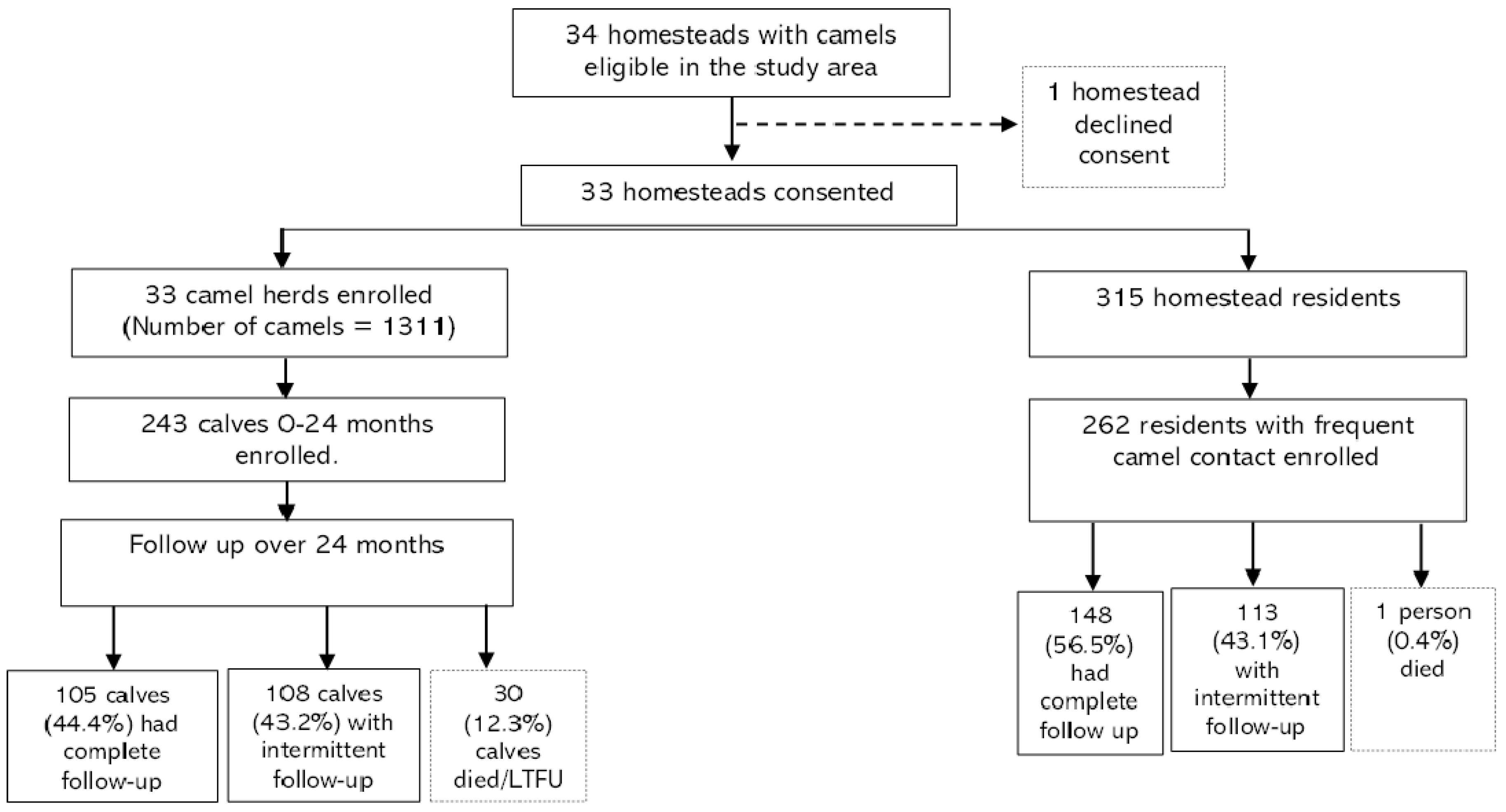
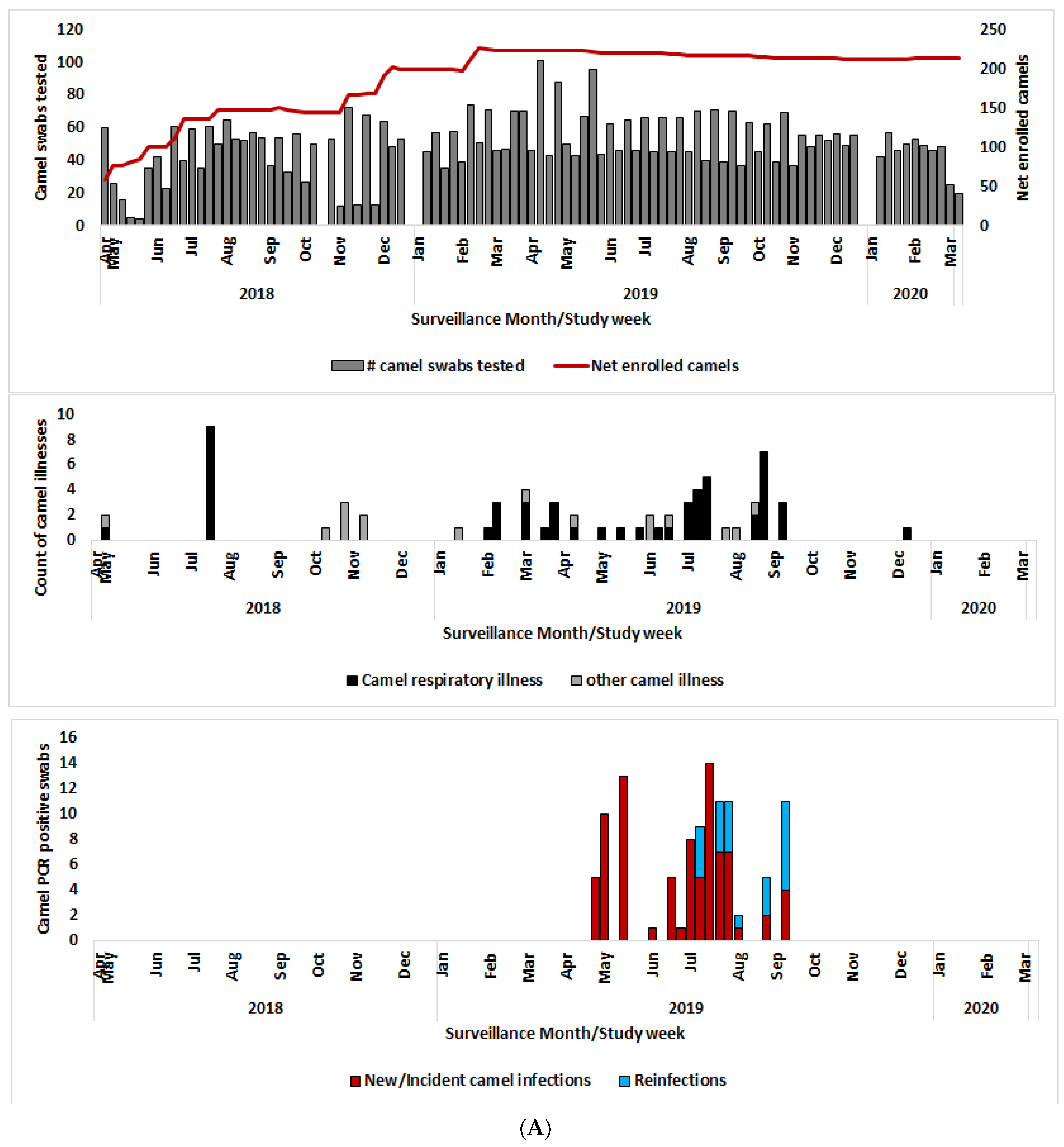
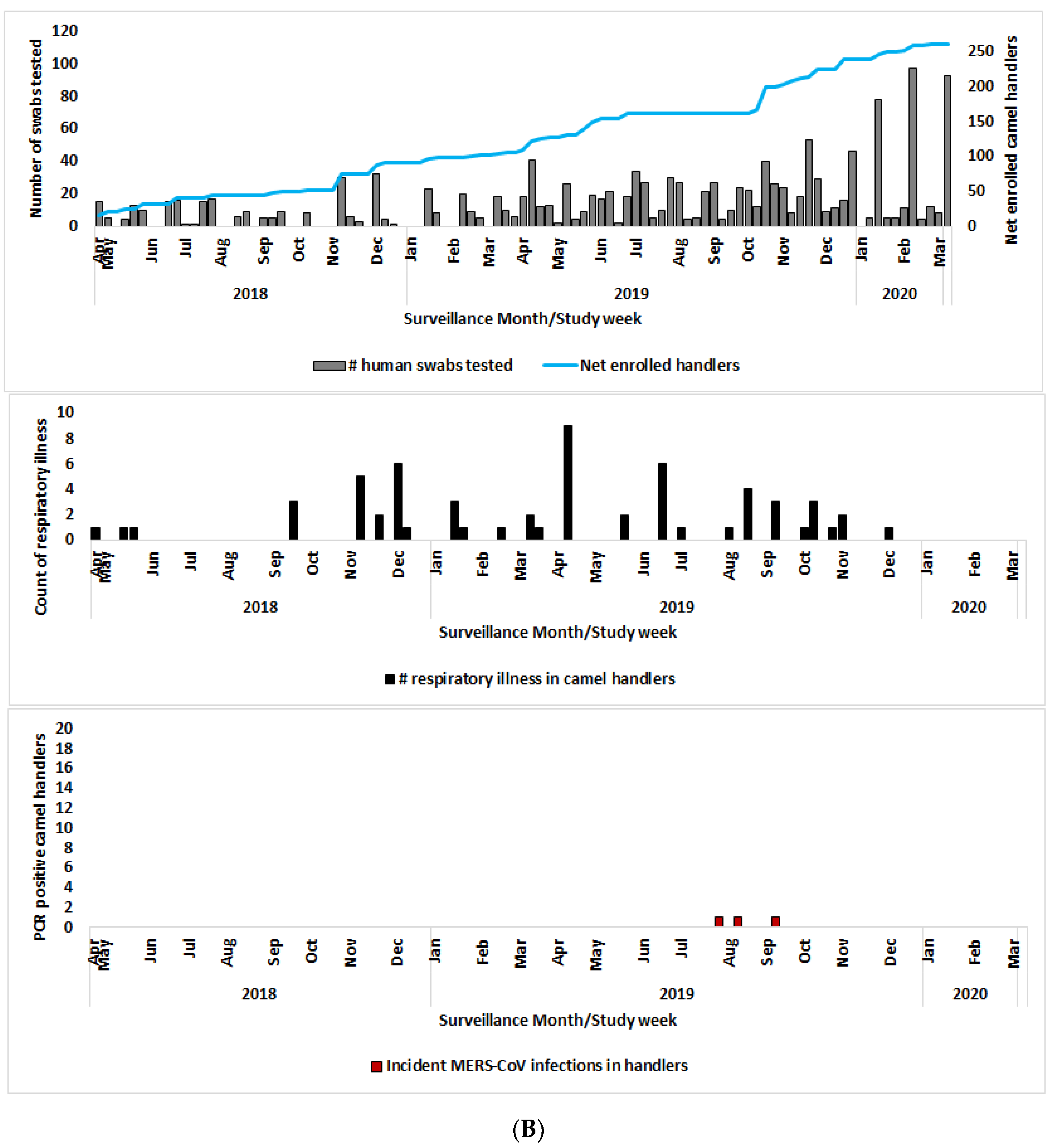
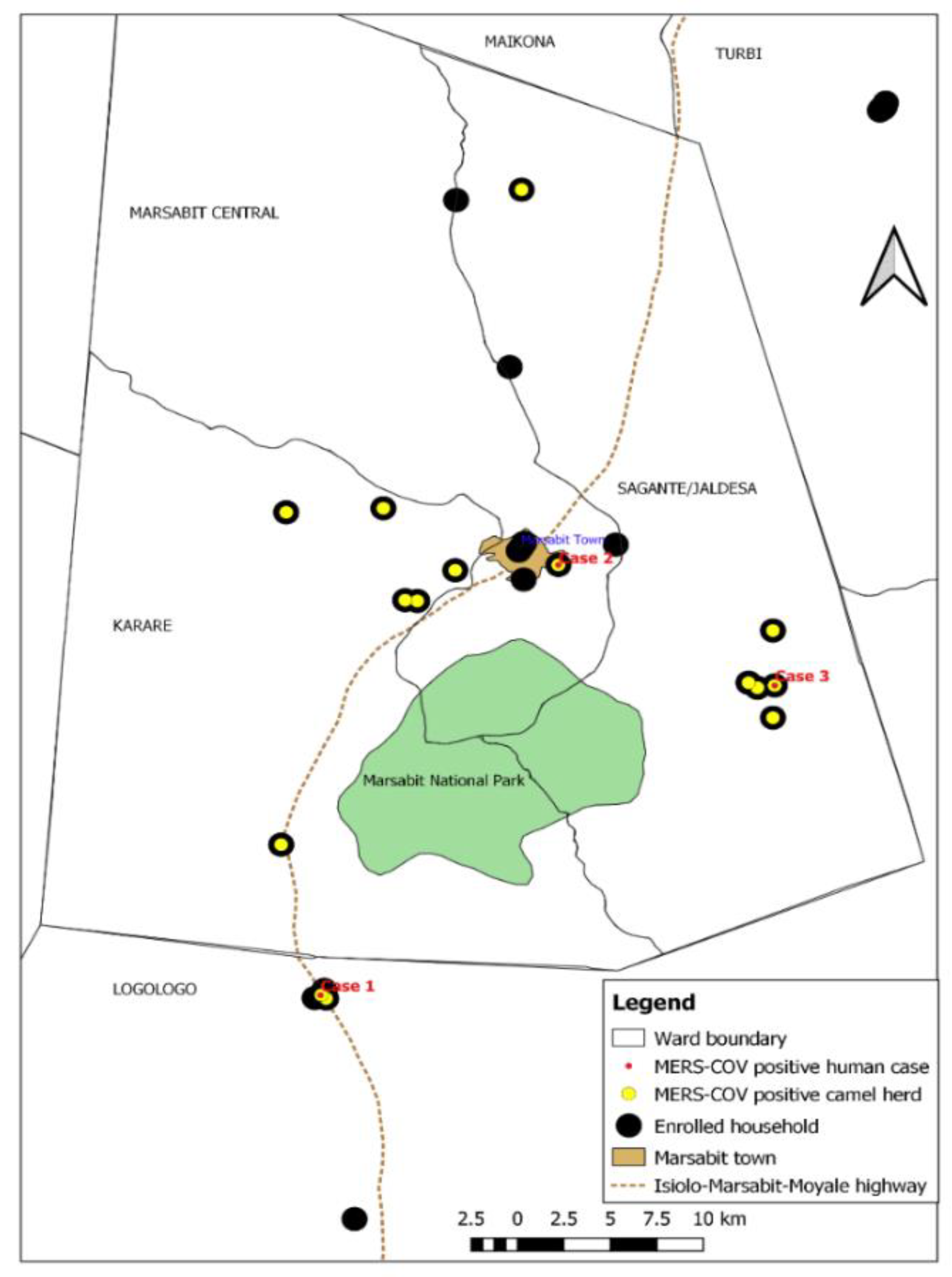
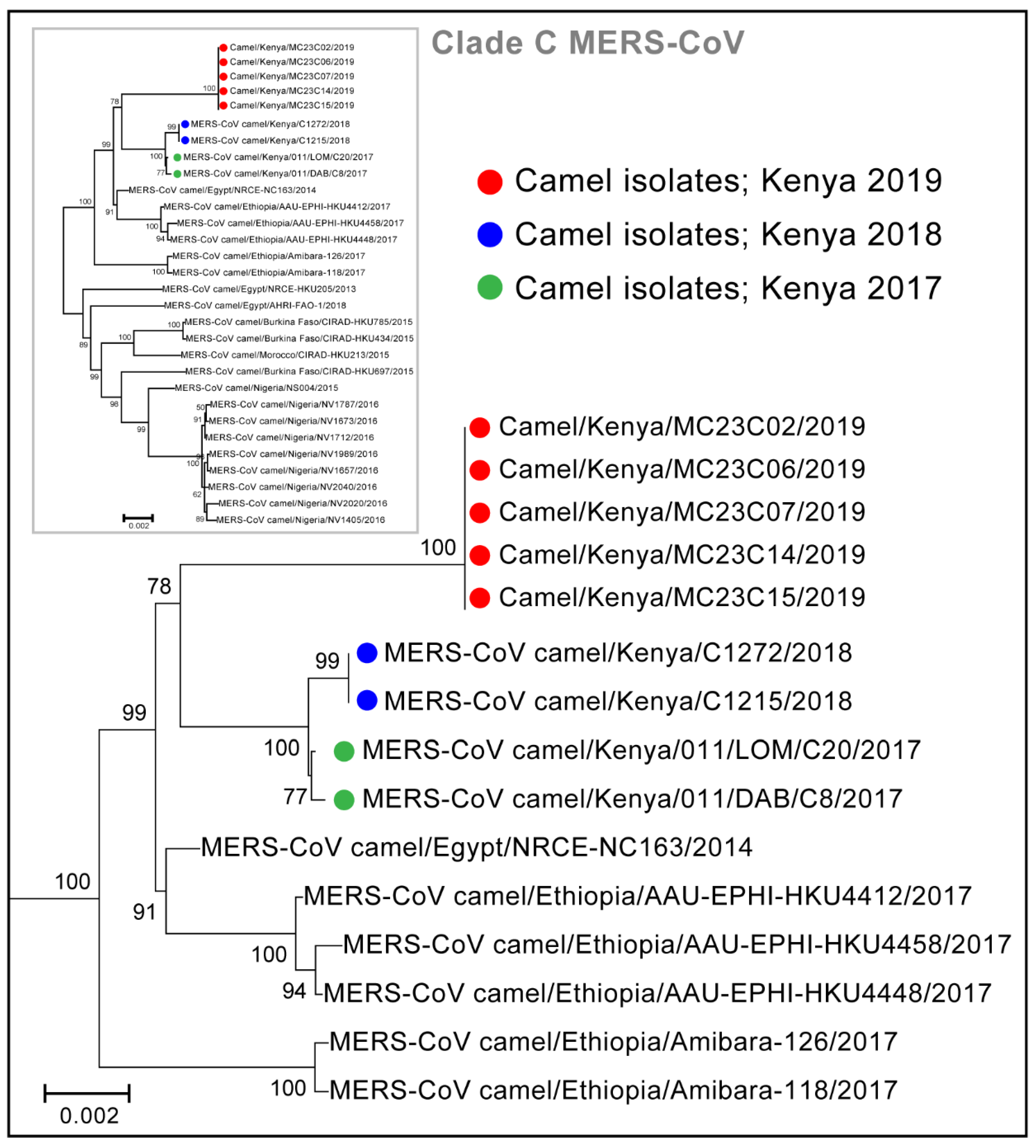
| Variable | Camels on Follow-Up during Outbreak Period ϕ (n = 162) | Swabs Collected (April–September 2019) (n = 1853) | Median Swabs per Calf (IQR) | PCR Positive (1st PCR Positive) n = 83 | Attack Rates ¶ % (95% CI) | p-Value |
|---|---|---|---|---|---|---|
| By Sex | ||||||
| Male | 86 (53.1%) | 963 (52.0%) | 14 (5–16) | 41 (49.4%) | 47.7% (36.8, 58.7) | Ref |
| Female | 76 (46.9%) | 890 (48.0%) | 14 (5–16) | 42 (50.6%) | 55.3% (43.4, 66.7) | 0.93 |
| By Age (in months) ƛ | ||||||
| 0–4 | 57 (35.2%) | 595 (32.1%) | 15 (5–16) | 24 (28.9%) | 42.1% (29.1, 55.9) | Ref |
| 5–12 | 20 (12.3%) | 285 (15.4%) | 16 (15–16) | 14 (16.9%) | 70.0% (45.7, 88.1) | 0.04 µ |
| 13–18 | 45 (27.8%) | 481 (26.0%) | 13 (5–15) | 22 (26.5%) | 48.9% (33.7, 64.2) | 0.49 |
| 19+ | 40 (24.7%) | 492 (26.6%) | 14 (11–15) | 23 (27.7%) | 57.5% (40.9, 72.9) | 0.14 |
| All calves | 162 (100.0%) | 1853 (100.0%) | 14 (5–16) | 83(100.0%) | 51.2% (43.3, 59.2) | NA |
| Variable | Camels with Repeat Infections * n (%) | OR (95% CI) | p-Value |
|---|---|---|---|
| Sex | |||
| Female | 7 (31.8%) | Ref | |
| Male | 15 (68.2%) | 2.88 (1.03–8.09) | 0.04 |
| By Age (months) | |||
| 0–4 | 3 (13.6%) | Ref | |
| 5–12 | 1 (4.5%) | 0.54 (0.01–7.67) | 1.00 |
| 13–18 | 10 (45.5%) | 5.83 (1.15–37.93) | 0.02 |
| 19+ | 8 (36.4%) | 3.73 (0.72–24.80) | 0.09 |
| All calves | 22 (100.0%) |
Publisher’s Note: MDPI stays neutral with regard to jurisdictional claims in published maps and institutional affiliations. |
© 2022 by the authors. Licensee MDPI, Basel, Switzerland. This article is an open access article distributed under the terms and conditions of the Creative Commons Attribution (CC BY) license (https://creativecommons.org/licenses/by/4.0/).
Share and Cite
Ngere, I.; Hunsperger, E.A.; Tong, S.; Oyugi, J.; Jaoko, W.; Harcourt, J.L.; Thornburg, N.J.; Oyas, H.; Muturi, M.; Osoro, E.M.; et al. Outbreak of Middle East Respiratory Syndrome Coronavirus in Camels and Probable Spillover Infection to Humans in Kenya. Viruses 2022, 14, 1743. https://doi.org/10.3390/v14081743
Ngere I, Hunsperger EA, Tong S, Oyugi J, Jaoko W, Harcourt JL, Thornburg NJ, Oyas H, Muturi M, Osoro EM, et al. Outbreak of Middle East Respiratory Syndrome Coronavirus in Camels and Probable Spillover Infection to Humans in Kenya. Viruses. 2022; 14(8):1743. https://doi.org/10.3390/v14081743
Chicago/Turabian StyleNgere, Isaac, Elizabeth A. Hunsperger, Suxiang Tong, Julius Oyugi, Walter Jaoko, Jennifer L. Harcourt, Natalie J. Thornburg, Harry Oyas, Mathew Muturi, Eric M. Osoro, and et al. 2022. "Outbreak of Middle East Respiratory Syndrome Coronavirus in Camels and Probable Spillover Infection to Humans in Kenya" Viruses 14, no. 8: 1743. https://doi.org/10.3390/v14081743
APA StyleNgere, I., Hunsperger, E. A., Tong, S., Oyugi, J., Jaoko, W., Harcourt, J. L., Thornburg, N. J., Oyas, H., Muturi, M., Osoro, E. M., Gachohi, J., Ombok, C., Dawa, J., Tao, Y., Zhang, J., Mwasi, L., Ochieng, C., Mwatondo, A., Bodha, B., ... Munyua, P. M. (2022). Outbreak of Middle East Respiratory Syndrome Coronavirus in Camels and Probable Spillover Infection to Humans in Kenya. Viruses, 14(8), 1743. https://doi.org/10.3390/v14081743






